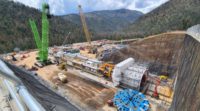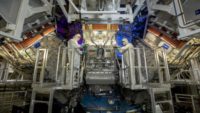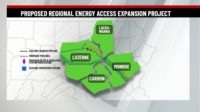As construction enters its third decade of the 21st century, the events and changes of the last 10 years within the industry and in the world it serves have been hugely dramatic—generating challenges yet to confront or understand, but also new opportunities for next-generation professionals to provide critically needed innovation in design and construction practice, technology and business.
The growing impacts and implications of climate change over the past 10 years have been a big story for ENR and its global audience, as new studies show that the window to take action to cut harmful emissions and address high-risk areas now is only a decade away.
“If nations aren’t in lockstep to make emissions cuts now, there is little chance to stay within the warming target,” said veteran engineer and sustainability advocate Bill Wallace in a 2018 ENR editorial. “The report says that, at 1.5° C and below (we’re now at 0.8° C), climate-change mitigation and adaptation can be managed. Above that, conditions get really dicey, and fixes are really expensive."
 |
| Sea-level rise in particular has created new vulnerabilities for populations centers on the costs and near other flood-prone water bodies. PHOTO BY EMILY MICHOT/MIAMI HERALD VIA AP |
Sea-level rise in particular has created new vulnerabilities for population centers on coasts and near other flood-prone water bodies that engineers and construction teams have addressed through hardened infrastructure and other innovation.
"Many cities are still trying to get a handle on the complex, interrelated problems. But others, such as Miami Beach, have started aggressive, multimillion-dollar programs to raise roads and improve drainage," a 2017 ENR special report pointed out. "Engineers are rethinking their practice, coming up with innovative, adaptive designs that will prevent overbuilding in the short term."
As such, the decade witnessed a boom in sustainability as an accepted and desired building approach by clients and as a new and growing service offering and market niche for industry firms.
Sustainability certification programs, which only included LEED for buildings in 2010, have exploded to include specialized standards, such as WELL Building, ParkSmart, Fitwel and Living Building Challenge for healthy buildings, and Envision for infrastructure.
Revenue levels for firms offering sustainability expertise boomed as well over the decade, with the Top 100 Green Design Firms generating $6.77 billion in 2018 design revenue, up 9% from the previous year, and Top 100 Green Contractors reporting $68.61 billion in 2018, up 10.5% from 2017.
Even with new resilience measures adopted since Hurricane Katrina slammed the Gulf Coast in 2005, climate-change related events still developed into damaging catastrophes during the decade—from Superstorm Sandy slamming low-lying coastal areas of the East Coast in 2012 to back-to-back damaging 2017 hurricanes Maria in the Caribbean and Harvey in Texas and the explosively deadly wildfires in California and more recently, in Australia, which have government and industry experts enacting and pondering even more extensive upgrades and building restrictions, hardening measures and resilience programs for the future.
Developers continued to push new energy projects but a growing number of public sector and environmentalist opponents of fossil-fuel energy construction also mounted new efforts through legislation, the ballot box and the courts to restrict or halt projects.
New concerns spawned a huge spurt in clean energy construction in the decade—from solar, wind and other renewables—that has propelled a new industry niche, as the federal government under President Barack Obama, and more recently states and localities, have mandated ambitious new goals and requirements to be included in the U.S. energy mix.
That ground-level impetus will continue in the next decade, even with unclear support, and what some see as strong opposition, from the Donald Trump administration.
Even so, global clean energy growth has been propelled in the past decade, as other nations have embraced the approach for economic as well as environmental reasons. Europe and China, for example, vastly expanded regional and national commitment to offshore wind energy, with the latter set to shortly become the world's largest market.
Upscaled
The infrastructure demands of growing populations, as well as the scale of legacy environmental problems and need for better construction efficiencies have scaled up energy and other sector projects over the decade, with "gigaproject" emerging as a new industry buzzword. The last ten years saw construction of a number of record transportation projects, including the new $5-billion Panama Canal, rail and transit upgrades in the U.K. and skyline-altering mega-crossings in New York in a push by the state's politically ambitious governor, Andrew Cuomo (D), not seen since the 1930s.
 |
| The last ten years saw construction of a number of record transportation projects, including a new $5-billion Panama Canal. Photo: Courtesy of the Panama Canal Authority |
Across the country, the Pacific Northwest also eyes an aggressive infrastructure program ahead.
But rising costs and politics have become bigger factors, as in California's now truncated push for high speed rail and the effort to bring light rail to car-centric Honolulu.
Projects to clean up legacy environmental waste showed some decade progress, such as at the U.S. Energy Dept.'s 560-sq-mile Hanford nuclear waste site in Washington state, where a long-gestating $17-billion production plant being built to finally get rid of millions of gallons of chemical and radioactive wastes stored underground since World War II, showed some promise as testing got closer in 2019 of the site's new vitrification plant, which will turn wastes to glass and is mandated to start up in 2023. But with its success not clear and with other site waste cleanup challenges, Hanford remains an environmental problem.
There were also key changes in handling wastes amassing at private nuclear power plants, with new technologies and business approaches offered by industry firms aimed at cutting years, or even decades, off time spans to decommission sites no longer economical in a more competitive energy marketplace since 2010.
As the decade brought new challenges to megaproject building, it also unveiled an evolution in project delivery, with key strides outlined by ENR in broadened use of innovative approaches such as integrated project delivery (IPD), and public-private partnerships (P3s), although not always smoothly with project risk balance growing as a bigger business management issue for contractors and owners, that remains ongoing heading into the new decade.
Design-build continued to grow as a preferred project delivery alternative, with 38 states passing enabling legislation by 2019, according to the Design-Build Institute of America.
Lessons Learned?
The push for efficiency, however, still did not forestall project calamities during the decade, whether by environmental causes or human error, which ranged from the tsunami-generated damage to Japan's poorly located Fukushima nuclear reactor in 2011 to to the epic 2018 collapse of what was supposed to be an iconic pedestrian bridge in Florida that instead killed eight motorists and has its construction team participants still embroiled in litigation. ENR compiled its first-ever list of the worst global projects in 2014.
Crane collapses on large urban projects, most recently in New York City, Seattle, Dallas and New Orleans, with worker and civilian casualties, also added to project complexities during the decade.
On the flip side, the industry showed its ingenuity and grit to billions around the world in aiding in the miraculous drilling effort in 2010 to rescue 33 Chilean miners who had been trapped 2,300 ft underground by shifting rock and earth for 69 days.
Pay It Forward
With problem-solving inherent for engineers and contractors, technology development made major strides in the last 10 years.
In a decade that saw drones go from weekend toys to critical tools for site documentation, and project data from a few servers in a trailer to a near-limitless cloud-storage analytics mine, construction has accelerated its embrace of new technologies.
Insights from logistics and manufacturing industries are driving new pushes into modular and prefab construction, while research into artificial intelligence and machine learning is fast altering project scheduling and delivery. The embrace of mobile devices both on and off the job site has changed the way that builders keep track of what they are building.
Construction has a reputation for being reticent to adopt new technologies, but the 2010s were a decade where many in the industry discovered how new tech can pay off.
Much of the technology push is linked to the skilled worker shortfall that has grown since 2010 as the construction workforce aged out or left the industry for other employment. The trend will continue, and likely worsen, in the coming years, but industry employers are also ramping up a push to recruit from non-traditional demographics to fill craft labor, professional and management ranks.
Women have made steady gains during the decade at the academic level in terms of earning engineering, construction and other industry related degrees and are populating more jobsites, cubicles and C-suites, but their movement up the ranks is not without pain points.
Women have made steady gains during the decade at the academic level in terms of earning engineering, construction and other industry related degrees and are populating more jobsites, cubicles and C-suites, but their movement up the ranks is not without pain points.
With "diversity and inclusion" becoming a more recognized part of the construction employment lexicon since 2010, and with widening workforce shortages in a booming industry, employers also boosted outreach to and recognition of a wider talent pool—although efforts and commitment will need to accelerate.
Challenging Times
The talent infusion comes as the industry recorded the loss of some noted luminaries in the last decade, from labor leaders like bricklayers' union President Jack Joyce and key U.S. infrastructure finance booster Rep. Jim Oberstar to corporate game-changers Ted Kennedy, former CEO of open-shop contractor BE&K, and Norberto Odebrecht, founder of the global construction firm that became a global powerhouse but now teeters on bankruptcy amid a corporate bribery scandal in Brazil and other countries that unfolded in the last several years.
The ethics scandals, which also enveloped Canada design-build giant SNC-Lavalin Group Inc. for most of the past decade based on alleged contract bribes by long-departed executives that was settled finally in 2019, was a painful construction-sector story, but helped usher in a new era of more transparent business practice that is critical to the industry's future ability to win work and attract talent.
Construction's dependence on a global workforce also grew during the 2010s, with more work shifted cross-border to enable 24/7 execution and greater use of non-citizen talent that includes visa'ed professionals and undocumented craft workers.
The Trump administration's shifting and unclear stance on immigration, and changing workforce rules in Europe's post-Brexit future present challenges as 2020 begins.
The human element will be critical to sustain industry growth in the next decade, with firms enjoying a bull market in most of the last decade buoyed by a surging stock market and global economy, even though it began on the heels of a crippling recession.
Some speculate a downturn is coming, but how big and whether it occurs this year remain disputed topics. ENR's decade-ending industry Confidence index published in December shows participants predicting a surprisingly resilient economy.
Hyper-Speed
Construction employers also have boosted their own resilience, adapting not just services, but also their very size and ownership structure through mergers and acquisitions that grew at hyperspeed in the last 10 years—hitting a pinnacle in 2014 with the combination of design giants AECOM and URS, and of Parsons Brinckerhoff and WSP, and continuing at a steady pace through now and beyond.
With the decade just a couple weeks old, the industry is abuzz with rumors that Montreal-based WSP's ambitous growth plans, generated an approach to AECOM about a possible purchase that could create a 100,000-person company. Industry analysts appear to see deal plausibility.
Jamie Cook, Credit Suisse managing diector, said in a Jan. 17 note that key AECOM activist investor, Starboard Value, "has been involved" in pushing for a deal to rev up stock value, which did rise last week, that its current Chairman and CEO Michael Burke's retirement is set before May without a successor named, that the two firms are heavily in lower-risk engineering market sectors, and that there could be cost synergies.. AECOM has spun off its government services business and is seeking a buyer for its civil construction operation.
She is "less optimistic" on revenue growth advantages and even noted some client "pushback" related to market overlap.
According to industry sources with knowledge of both firms who voice some skepticism the deal will happen, there would be "significant overlap" in transportation and building design sectors and the potential of layoffs, although AECOM would offer architectural services capabilities that WSP lacks.
"If they execute this well, it could work," says one executive. "Size is not a detriment unless it gets in the way. This is still a people business."
AECOM will announce on Feb. 3, noon, its first quarter fiscal 2020 results and "value creation" efforts. WSP's year-end 2019 numbers and future strategy is expected also in early February. Stay tuned.
But the acquisition approach hasn't generated stellar results for all blended construction sector firms this decade, with one former top executive terming M&A a "1 plus 1 equals 1:8 proposition."
Many industry participants seek growth in other ways.
Said an executive of one design firm to ENR: “Too much time and effort is devoted to trying to merge disparate cultures, agendas, markets and the like, taking top management attention away from clients and the work. We call it the march to mediocrity.”







Post a comment to this article
Report Abusive Comment